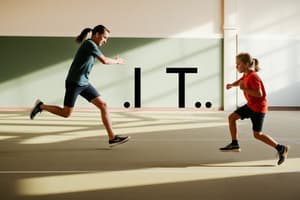Podcast
Questions and Answers
What is the purpose of fundamental movement skills?
What is the purpose of fundamental movement skills?
- To improve academic performance
- To provide a foundation for advanced physical activities (correct)
- To develop artistic abilities
- To enhance social skills
How can movement principles be introduced to students?
How can movement principles be introduced to students?
- Through adult-level training programs
- Through theoretical lectures only
- In age-appropriate and simple methods (correct)
- In complex and advanced ways
What are some health risks associated with a sedentary lifestyle?
What are some health risks associated with a sedentary lifestyle?
- Decreased risk of heart disease
- Increased risk of obesity and diabetes (correct)
- Enhanced social behavior
- Improved fitness levels
Why are fundamental movement skills considered essential?
Why are fundamental movement skills considered essential?
How do movement principles evolve with improving movement competence?
How do movement principles evolve with improving movement competence?
What is the main difference between physical activity and physical exercise?
What is the main difference between physical activity and physical exercise?
Why is body composition important in health and fitness?
Why is body composition important in health and fitness?
Why is it important to measure Body Fat Percentage (BFP) in health and fitness?
Why is it important to measure Body Fat Percentage (BFP) in health and fitness?
What should a training program take into account when matching the demands of an individual?
What should a training program take into account when matching the demands of an individual?
Why do most people not move enough despite the benefits of regular physical exercise?
Why do most people not move enough despite the benefits of regular physical exercise?
Flashcards are hidden until you start studying
Study Notes
Fundamental Movement Skills
- Involve the use of different body parts, such as feet, legs, shoulders, body, head, arms, and hands.
- Are the foundation for more advanced and specialized skills in various games, sports, and leisure activities.
Movement Principles
- Provide a solid foundation for physical activities in any environment, with or without equipment.
- Can be introduced in simple, age-appropriate ways to improve movement efficiency and effectiveness.
- Application of these principles becomes more refined as movement competence improves.
Health Risks of Sedentary Life
- Sedentary activity is associated with unfavorable health effects, including obesity, decline in cardiometabolic health, fitness, pro-social/behavioral behavior, and sleep duration in children and adolescents.
- In adults, sedentary lifestyle increases the risk of diseases such as heart disease, cancer, and diabetes, and is a cause of premature death.
Physical Activity and Physical Exercise
- Physical activity is any movement that requires energy from the muscles.
- Physical exercise is planned, systematic, repetitive, and intentional movement that can develop or maintain physical fitness.
Benefits of Regular Physical Exercise
- Lowers the risk of chronic disease and improves quality of life.
- Can be adapted to individual capabilities, regardless of age or limitations.
Balance and Coordination
- Can be improved through simple, dynamic movements while standing or sitting on an exercise ball with a spotter.
- Specific activities can be taken up to improve balance and coordination.
Training Program
- Must be devised to match individual demands, considering factors such as gender, age, strengths, weaknesses, objectives, and training facilities.
- A single training program cannot be suited for all individuals due to unique needs.
Body Composition
- Is characterized by percentages of fat, bone, and muscle in the human body.
- Body fat percentage is relevant in determining health, as muscle tissue is thicker than fat tissue.
Body Fat Percentage (BFP)
- Reflects the percentage of bodyweight that is fat.
- Can be measured by computing the "total mass of fat divided by total body mass, multiplied by 100."
- Lean mass is the percentage of the body that is not fat.
Studying That Suits You
Use AI to generate personalized quizzes and flashcards to suit your learning preferences.




